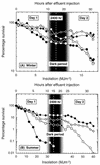Sunlight inactivation of fecal indicator bacteria and bacteriophages from waste stabilization pond effluent in fresh and saline waters
- PMID: 11872459
- PMCID: PMC123754
- DOI: 10.1128/AEM.68.3.1122-1131.2002
Sunlight inactivation of fecal indicator bacteria and bacteriophages from waste stabilization pond effluent in fresh and saline waters
Abstract
Sunlight inactivation in fresh (river) water of fecal coliforms, enterococci, Escherichia coli, somatic coliphages, and F-RNA phages from waste stabilization pond (WSP) effluent was compared. Ten experiments were conducted outdoors in 300-liter chambers, held at 14C (mean river water temperature). Sunlight inactivation (k(S)) rates, as a function of cumulative global solar radiation (insolation), were all more than 10 times higher than the corresponding dark inactivation (k(D)) rates in enclosed (control) chambers. The overall k(S) ranking (from greatest to least inactivation) was as follows: enterococci > fecal coliforms greater-than-or-equal E. coli > somatic coliphages > F-RNA phages. In winter, fecal coliform and enterococci inactivation rates were similar but, in summer, enterococci were inactivated far more rapidly. In four experiments that included freshwater-raw sewage mixtures, enterococci survived longer than fecal coliforms (a pattern opposite to that observed with the WSP effluent), but there was little difference in phage inactivation between effluents. In two experiments which included simulated estuarine water and seawater, sunlight inactivation of all of the indicators increased with increasing salinity. Inactivation rates in freshwater, as seen under different optical filters, decreased with the increase in the spectral cutoff (50% light transmission) wavelength. The enterococci and F-RNA phages were inactivated by a wide range of wavelengths, suggesting photooxidative damage. Inactivation of fecal coliforms and somatic coliphages was mainly by shorter (UV-B) wavelengths, a result consistent with photobiological damage. Fecal coliform repair mechanisms appear to be activated in WSPs, and the surviving cells exhibit greater sunlight resistance in natural waters than those from raw sewage. In contrast, enterococci appear to suffer photooxidative damage in WSPs, rendering them susceptible to further photooxidative damage after discharge. This suggests that they are unsuitable as indicators of WSP effluent discharges to natural waters. Although somatic coliphages are more sunlight resistant than the other indicators in seawater, F-RNA phages are the most resistant in freshwater, where they may thus better represent enteric virus survival.
Figures





References
-
- American Public Health Association. 1998. Standard methods for the examination of water and wastewater, 20th ed. American Public Health Association, AWWA, WPCF, Washington, D.C.
-
- Calkins, J., and J. A. Barcelo. 1982. Action spectra, p. 143-150. In J. Calkins (ed.), The role of solar ultraviolet radiation in marine ecosystems. Plenum Press, New York, N.Y.
-
- Davies-Colley, R. J., A. M. Donnison, and D. J. Speed. 1997. Sunlight wavelengths inactivating faecal indicator microorganisms in waste stabilisation ponds. Water Sci. Technol. 35:219-255.
-
- Davies-Colley, R. J., A. M. Donnison, D. J. Speed, C. M. Ross, and J. W. Nagels. 1999. Inactivation of faecal indicator microorganisms in waste stabilisation ponds: interaction of environmental factors with sunlight. Water Res. 33:1220-1230.
Publication types
MeSH terms
Substances
LinkOut - more resources
Full Text Sources
Medical

